Detailed Report on Car Fringe Benefits, FBT Liability, and Tax Law
VerifiedAdded on 2023/06/07
|8
|2296
|334
Report
AI Summary
This report provides a comprehensive analysis of car fringe benefits and the associated Fringe Benefits Tax (FBT) liability for employers. It begins by defining car fringe benefits and explaining when they arise, referencing relevant sections of the Fringe Benefit Tax Assessment Act 1986 (FBTAA 86). The report outlines the computation of FBT liability, which involves three key steps: calculating the taxable value of the car fringe benefit using either the statutory formula or the cost basis method, determining the taxable value of fringe benefits using a gross-up factor, and finally, computing the FBT payable based on the taxable value and the applicable FBT rate. The report includes a detailed example, demonstrating the calculation of FBT payable using both the statutory and cost basis methods, highlighting the factors that influence the final FBT liability, such as the car's value, the number of days of private usage, and operating expenses. The report emphasizes that the employer bears the FBT liability, providing valuable insights into tax planning for fringe benefits.
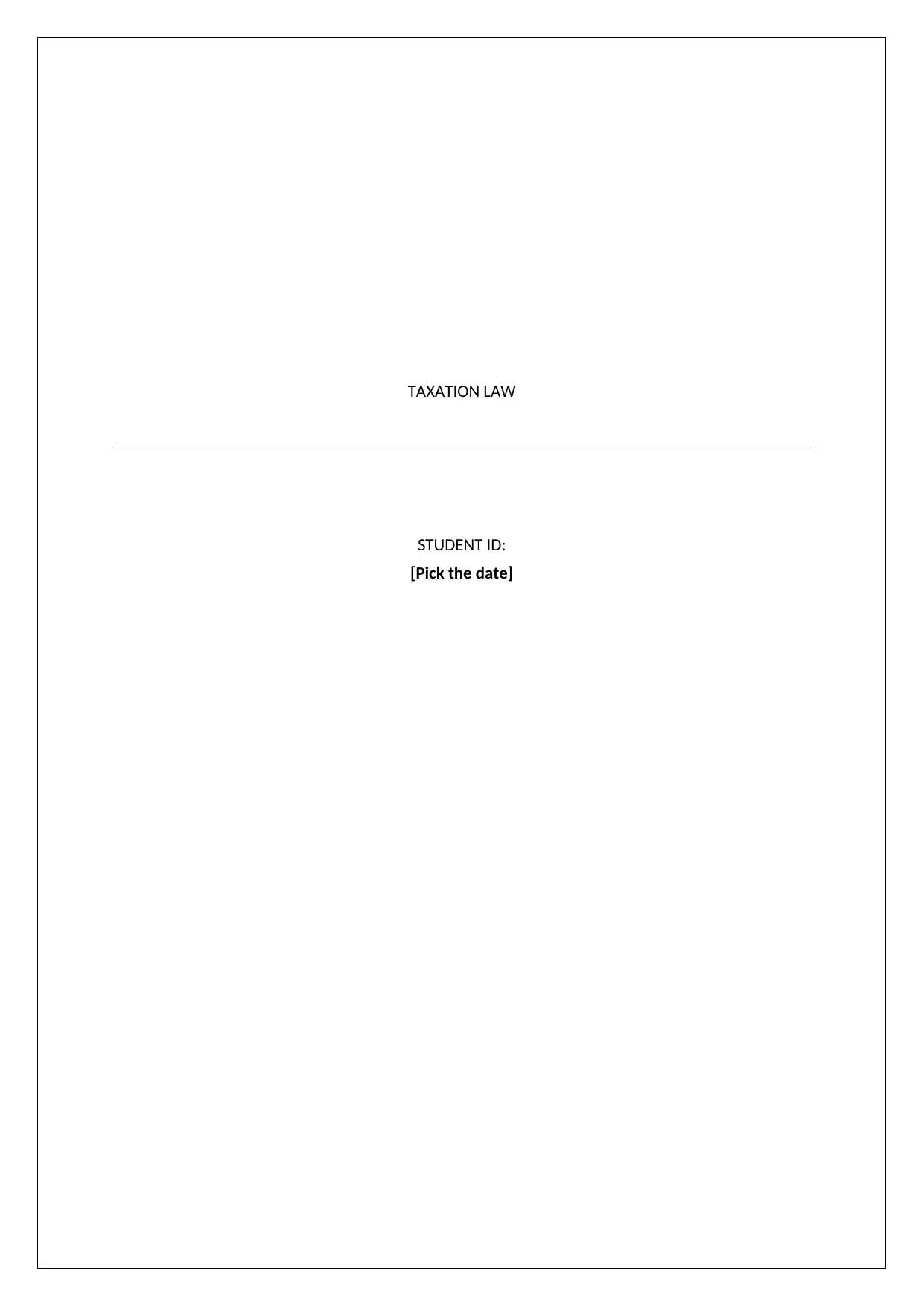
TAXATION LAW
STUDENT ID:
[Pick the date]
STUDENT ID:
[Pick the date]
Paraphrase This Document
Need a fresh take? Get an instant paraphrase of this document with our AI Paraphraser

Introduction
Fringe benefits are essentially non-cash benefits provided to employees. It is imperative to
note that these benefits are extended for personal use. There are various types of fringe
benefits that may be extended to employee such as employer paying private expense of
employee, providing loan at subsidised interest rates, waiver of debt, car parking benefits and
other benefits. One of the most common fringe benefits is the car fringe benefit. It is
imperative to note that the car fringe benefits would tend to arise when an employer owner
car is provided to the employee for personal purpose. The same would also be used for work
purposes but private usage is critical. The car fringe benefits are dealt with Division 2 in Part
III of the Fringe Benefit Tax Assessment Act, 1986 (FBTAA 86) (Krever, 2016). The
objective of the given report is to highlight car fringe benefits and the computation of related
FBT liability on employer. It is noteworthy that no car related FBT liability would arise on
the employee.
Car Fringe Benefits
In accordance with s. 7(1) FBTAA 1986, it is assumed that the car fringe benefit is extended
if the car provided by employer or an associated of the employer is used for private or
personal work by the employee or concerned associate of employee. Also, it is noteworthy
that the actual usage of the car for private purpose is not mandatory as the conduct of the
employer and employee in terms of car can also indicate that private usage of car is allowed
or not (Barkoczy, 2017). This has been highlighted in s. 7(2) FBTAA 1986 as per which if
the employer owned car is garaged at the employee or associate residence or near the same,
then it would be assumed that the vehicle is available for private usage irrespective of the
employee or associate actually engaging in the same. Further, it is noteworthy that there are
certain car benefits which are exempt as has been defined in s. 8 FBTAA 1986. Also, the
scenario, where the car is exclusively used only for business or work purposes, the underlying
FBT implications would not arise since private usage is absolutely necessary. (Sadiq et. al.,
2016).
Computation of car related FBT
As highlighted above, the entire FBT liability falls on the employer and no FBT liability has
to be borne by the employee. The computation of FBT liability is not a one-step procedure
and instead involves three different steps. The first of these relate to computation of the car
Fringe benefits are essentially non-cash benefits provided to employees. It is imperative to
note that these benefits are extended for personal use. There are various types of fringe
benefits that may be extended to employee such as employer paying private expense of
employee, providing loan at subsidised interest rates, waiver of debt, car parking benefits and
other benefits. One of the most common fringe benefits is the car fringe benefit. It is
imperative to note that the car fringe benefits would tend to arise when an employer owner
car is provided to the employee for personal purpose. The same would also be used for work
purposes but private usage is critical. The car fringe benefits are dealt with Division 2 in Part
III of the Fringe Benefit Tax Assessment Act, 1986 (FBTAA 86) (Krever, 2016). The
objective of the given report is to highlight car fringe benefits and the computation of related
FBT liability on employer. It is noteworthy that no car related FBT liability would arise on
the employee.
Car Fringe Benefits
In accordance with s. 7(1) FBTAA 1986, it is assumed that the car fringe benefit is extended
if the car provided by employer or an associated of the employer is used for private or
personal work by the employee or concerned associate of employee. Also, it is noteworthy
that the actual usage of the car for private purpose is not mandatory as the conduct of the
employer and employee in terms of car can also indicate that private usage of car is allowed
or not (Barkoczy, 2017). This has been highlighted in s. 7(2) FBTAA 1986 as per which if
the employer owned car is garaged at the employee or associate residence or near the same,
then it would be assumed that the vehicle is available for private usage irrespective of the
employee or associate actually engaging in the same. Further, it is noteworthy that there are
certain car benefits which are exempt as has been defined in s. 8 FBTAA 1986. Also, the
scenario, where the car is exclusively used only for business or work purposes, the underlying
FBT implications would not arise since private usage is absolutely necessary. (Sadiq et. al.,
2016).
Computation of car related FBT
As highlighted above, the entire FBT liability falls on the employer and no FBT liability has
to be borne by the employee. The computation of FBT liability is not a one-step procedure
and instead involves three different steps. The first of these relate to computation of the car
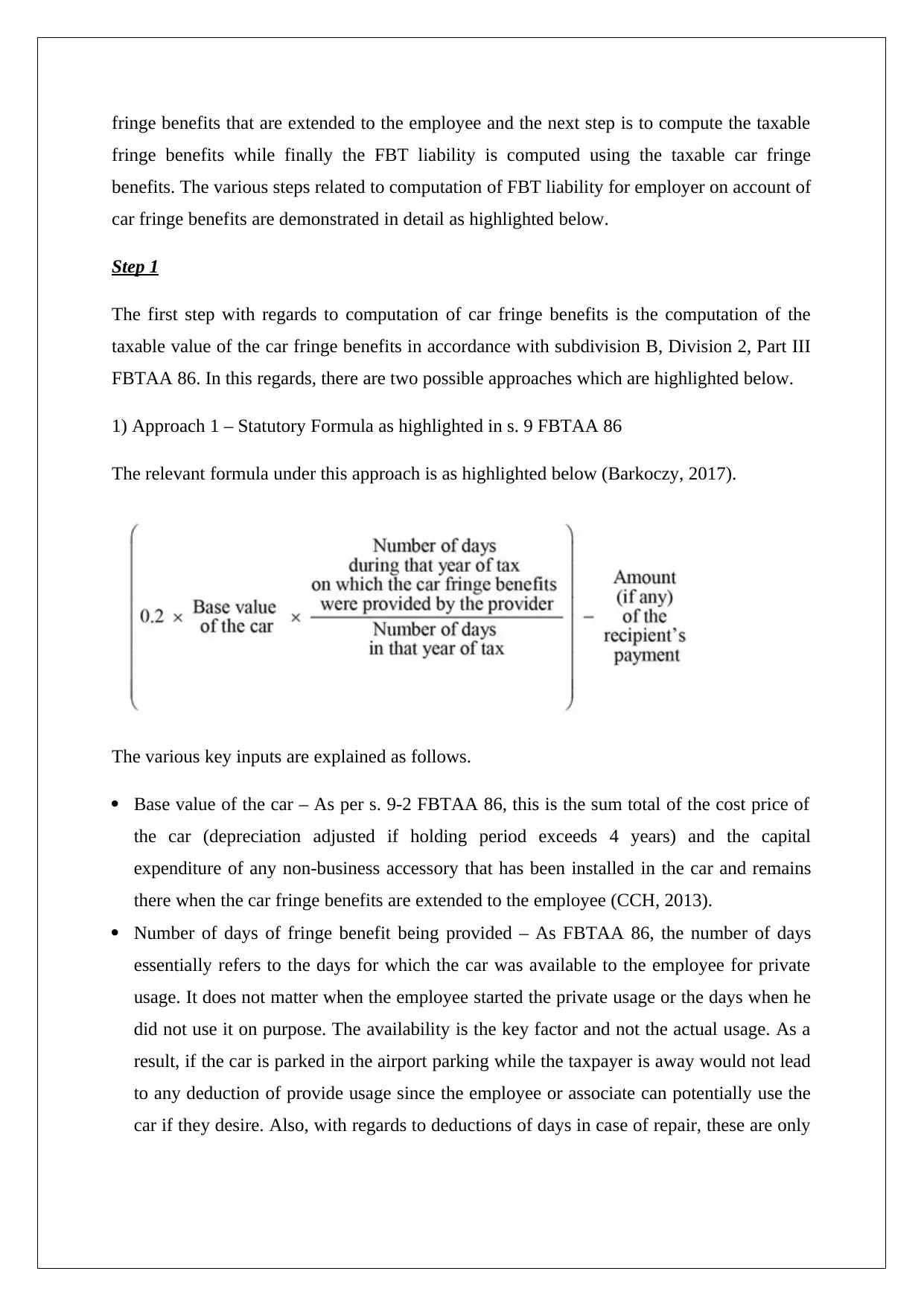
fringe benefits that are extended to the employee and the next step is to compute the taxable
fringe benefits while finally the FBT liability is computed using the taxable car fringe
benefits. The various steps related to computation of FBT liability for employer on account of
car fringe benefits are demonstrated in detail as highlighted below.
Step 1
The first step with regards to computation of car fringe benefits is the computation of the
taxable value of the car fringe benefits in accordance with subdivision B, Division 2, Part III
FBTAA 86. In this regards, there are two possible approaches which are highlighted below.
1) Approach 1 – Statutory Formula as highlighted in s. 9 FBTAA 86
The relevant formula under this approach is as highlighted below (Barkoczy, 2017).
The various key inputs are explained as follows.
Base value of the car – As per s. 9-2 FBTAA 86, this is the sum total of the cost price of
the car (depreciation adjusted if holding period exceeds 4 years) and the capital
expenditure of any non-business accessory that has been installed in the car and remains
there when the car fringe benefits are extended to the employee (CCH, 2013).
Number of days of fringe benefit being provided – As FBTAA 86, the number of days
essentially refers to the days for which the car was available to the employee for private
usage. It does not matter when the employee started the private usage or the days when he
did not use it on purpose. The availability is the key factor and not the actual usage. As a
result, if the car is parked in the airport parking while the taxpayer is away would not lead
to any deduction of provide usage since the employee or associate can potentially use the
car if they desire. Also, with regards to deductions of days in case of repair, these are only
fringe benefits while finally the FBT liability is computed using the taxable car fringe
benefits. The various steps related to computation of FBT liability for employer on account of
car fringe benefits are demonstrated in detail as highlighted below.
Step 1
The first step with regards to computation of car fringe benefits is the computation of the
taxable value of the car fringe benefits in accordance with subdivision B, Division 2, Part III
FBTAA 86. In this regards, there are two possible approaches which are highlighted below.
1) Approach 1 – Statutory Formula as highlighted in s. 9 FBTAA 86
The relevant formula under this approach is as highlighted below (Barkoczy, 2017).
The various key inputs are explained as follows.
Base value of the car – As per s. 9-2 FBTAA 86, this is the sum total of the cost price of
the car (depreciation adjusted if holding period exceeds 4 years) and the capital
expenditure of any non-business accessory that has been installed in the car and remains
there when the car fringe benefits are extended to the employee (CCH, 2013).
Number of days of fringe benefit being provided – As FBTAA 86, the number of days
essentially refers to the days for which the car was available to the employee for private
usage. It does not matter when the employee started the private usage or the days when he
did not use it on purpose. The availability is the key factor and not the actual usage. As a
result, if the car is parked in the airport parking while the taxpayer is away would not lead
to any deduction of provide usage since the employee or associate can potentially use the
car if they desire. Also, with regards to deductions of days in case of repair, these are only
⊘ This is a preview!⊘
Do you want full access?
Subscribe today to unlock all pages.

Trusted by 1+ million students worldwide
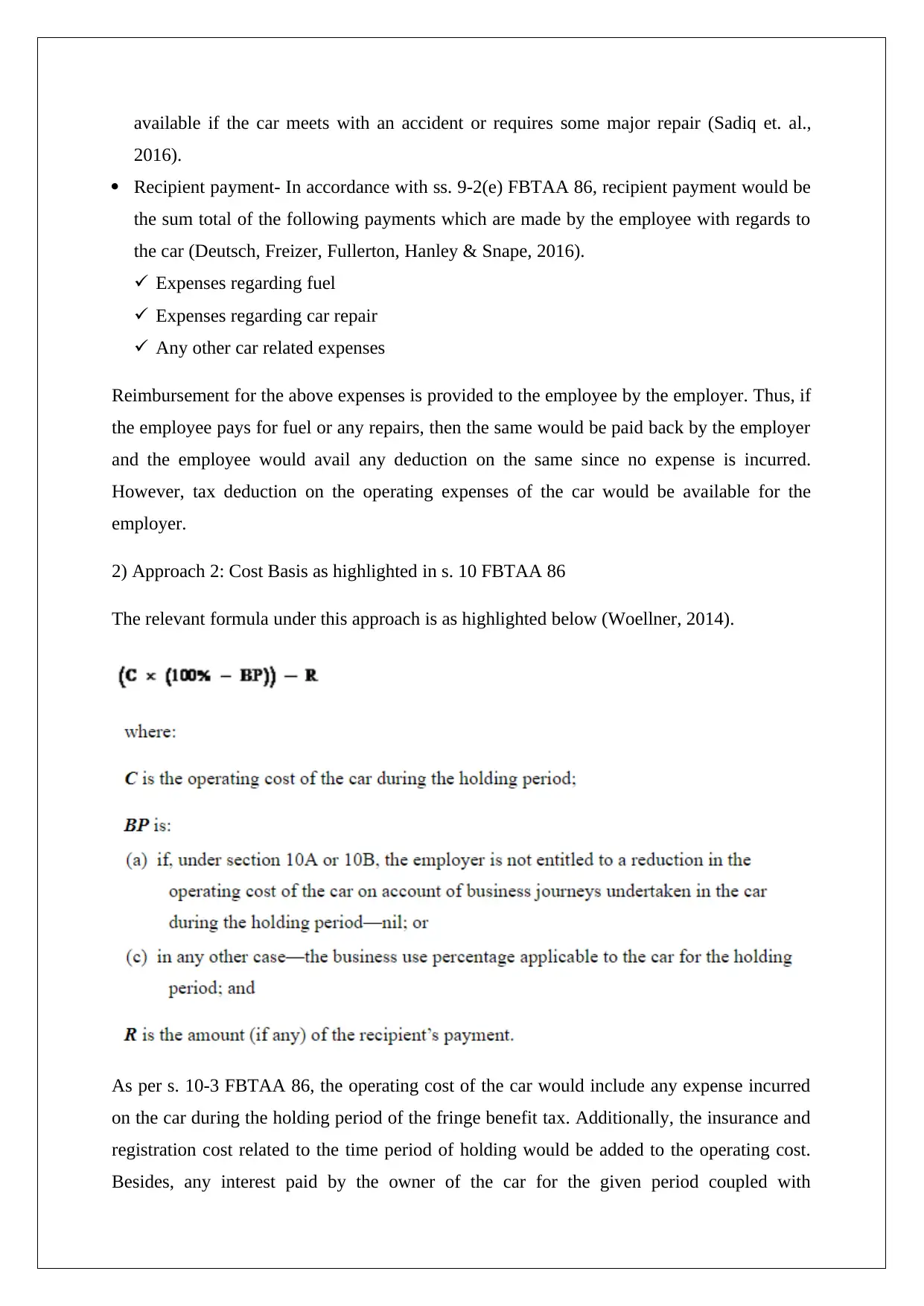
available if the car meets with an accident or requires some major repair (Sadiq et. al.,
2016).
Recipient payment- In accordance with ss. 9-2(e) FBTAA 86, recipient payment would be
the sum total of the following payments which are made by the employee with regards to
the car (Deutsch, Freizer, Fullerton, Hanley & Snape, 2016).
Expenses regarding fuel
Expenses regarding car repair
Any other car related expenses
Reimbursement for the above expenses is provided to the employee by the employer. Thus, if
the employee pays for fuel or any repairs, then the same would be paid back by the employer
and the employee would avail any deduction on the same since no expense is incurred.
However, tax deduction on the operating expenses of the car would be available for the
employer.
2) Approach 2: Cost Basis as highlighted in s. 10 FBTAA 86
The relevant formula under this approach is as highlighted below (Woellner, 2014).
As per s. 10-3 FBTAA 86, the operating cost of the car would include any expense incurred
on the car during the holding period of the fringe benefit tax. Additionally, the insurance and
registration cost related to the time period of holding would be added to the operating cost.
Besides, any interest paid by the owner of the car for the given period coupled with
2016).
Recipient payment- In accordance with ss. 9-2(e) FBTAA 86, recipient payment would be
the sum total of the following payments which are made by the employee with regards to
the car (Deutsch, Freizer, Fullerton, Hanley & Snape, 2016).
Expenses regarding fuel
Expenses regarding car repair
Any other car related expenses
Reimbursement for the above expenses is provided to the employee by the employer. Thus, if
the employee pays for fuel or any repairs, then the same would be paid back by the employer
and the employee would avail any deduction on the same since no expense is incurred.
However, tax deduction on the operating expenses of the car would be available for the
employer.
2) Approach 2: Cost Basis as highlighted in s. 10 FBTAA 86
The relevant formula under this approach is as highlighted below (Woellner, 2014).
As per s. 10-3 FBTAA 86, the operating cost of the car would include any expense incurred
on the car during the holding period of the fringe benefit tax. Additionally, the insurance and
registration cost related to the time period of holding would be added to the operating cost.
Besides, any interest paid by the owner of the car for the given period coupled with
Paraphrase This Document
Need a fresh take? Get an instant paraphrase of this document with our AI Paraphraser
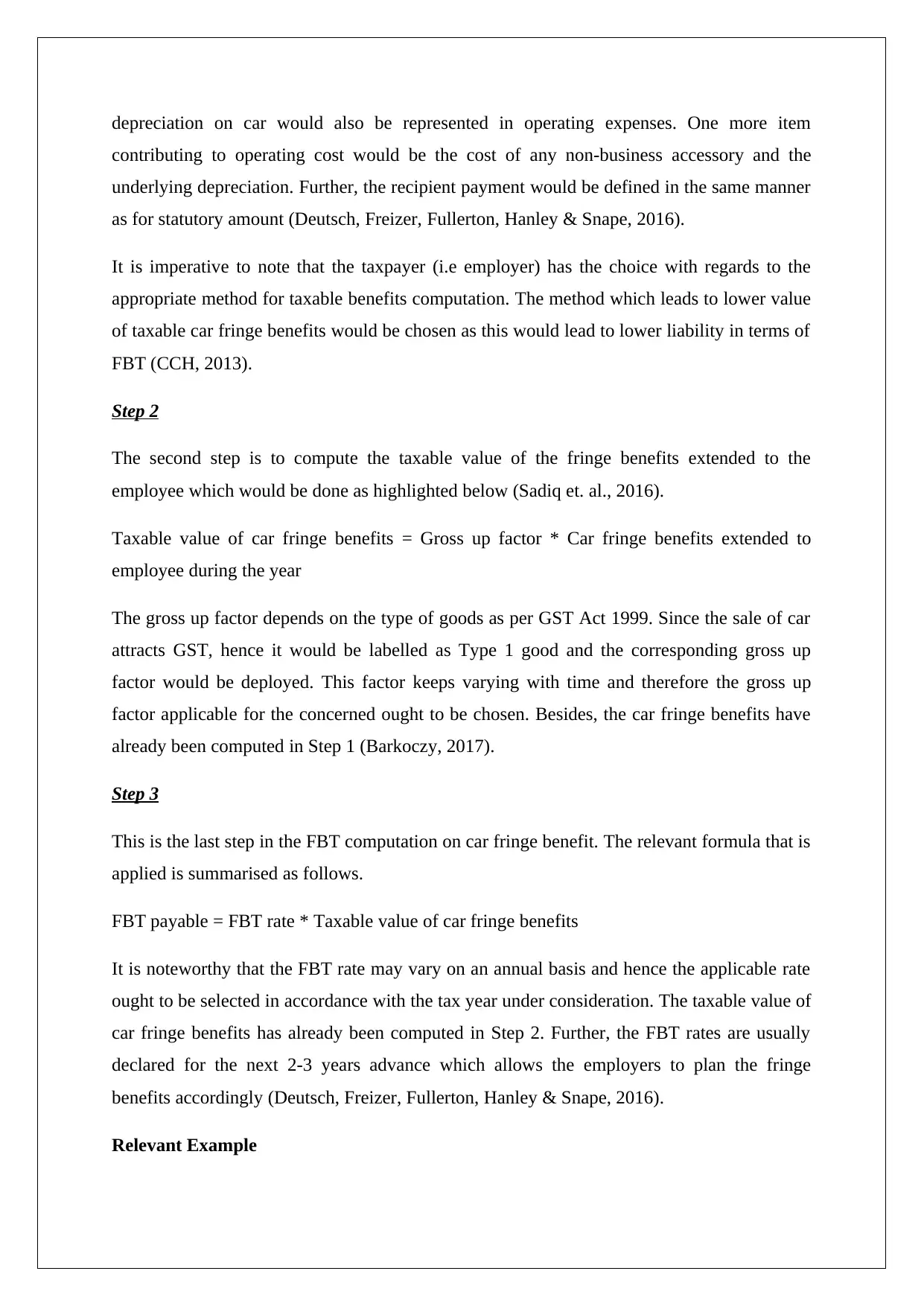
depreciation on car would also be represented in operating expenses. One more item
contributing to operating cost would be the cost of any non-business accessory and the
underlying depreciation. Further, the recipient payment would be defined in the same manner
as for statutory amount (Deutsch, Freizer, Fullerton, Hanley & Snape, 2016).
It is imperative to note that the taxpayer (i.e employer) has the choice with regards to the
appropriate method for taxable benefits computation. The method which leads to lower value
of taxable car fringe benefits would be chosen as this would lead to lower liability in terms of
FBT (CCH, 2013).
Step 2
The second step is to compute the taxable value of the fringe benefits extended to the
employee which would be done as highlighted below (Sadiq et. al., 2016).
Taxable value of car fringe benefits = Gross up factor * Car fringe benefits extended to
employee during the year
The gross up factor depends on the type of goods as per GST Act 1999. Since the sale of car
attracts GST, hence it would be labelled as Type 1 good and the corresponding gross up
factor would be deployed. This factor keeps varying with time and therefore the gross up
factor applicable for the concerned ought to be chosen. Besides, the car fringe benefits have
already been computed in Step 1 (Barkoczy, 2017).
Step 3
This is the last step in the FBT computation on car fringe benefit. The relevant formula that is
applied is summarised as follows.
FBT payable = FBT rate * Taxable value of car fringe benefits
It is noteworthy that the FBT rate may vary on an annual basis and hence the applicable rate
ought to be selected in accordance with the tax year under consideration. The taxable value of
car fringe benefits has already been computed in Step 2. Further, the FBT rates are usually
declared for the next 2-3 years advance which allows the employers to plan the fringe
benefits accordingly (Deutsch, Freizer, Fullerton, Hanley & Snape, 2016).
Relevant Example
contributing to operating cost would be the cost of any non-business accessory and the
underlying depreciation. Further, the recipient payment would be defined in the same manner
as for statutory amount (Deutsch, Freizer, Fullerton, Hanley & Snape, 2016).
It is imperative to note that the taxpayer (i.e employer) has the choice with regards to the
appropriate method for taxable benefits computation. The method which leads to lower value
of taxable car fringe benefits would be chosen as this would lead to lower liability in terms of
FBT (CCH, 2013).
Step 2
The second step is to compute the taxable value of the fringe benefits extended to the
employee which would be done as highlighted below (Sadiq et. al., 2016).
Taxable value of car fringe benefits = Gross up factor * Car fringe benefits extended to
employee during the year
The gross up factor depends on the type of goods as per GST Act 1999. Since the sale of car
attracts GST, hence it would be labelled as Type 1 good and the corresponding gross up
factor would be deployed. This factor keeps varying with time and therefore the gross up
factor applicable for the concerned ought to be chosen. Besides, the car fringe benefits have
already been computed in Step 1 (Barkoczy, 2017).
Step 3
This is the last step in the FBT computation on car fringe benefit. The relevant formula that is
applied is summarised as follows.
FBT payable = FBT rate * Taxable value of car fringe benefits
It is noteworthy that the FBT rate may vary on an annual basis and hence the applicable rate
ought to be selected in accordance with the tax year under consideration. The taxable value of
car fringe benefits has already been computed in Step 2. Further, the FBT rates are usually
declared for the next 2-3 years advance which allows the employers to plan the fringe
benefits accordingly (Deutsch, Freizer, Fullerton, Hanley & Snape, 2016).
Relevant Example
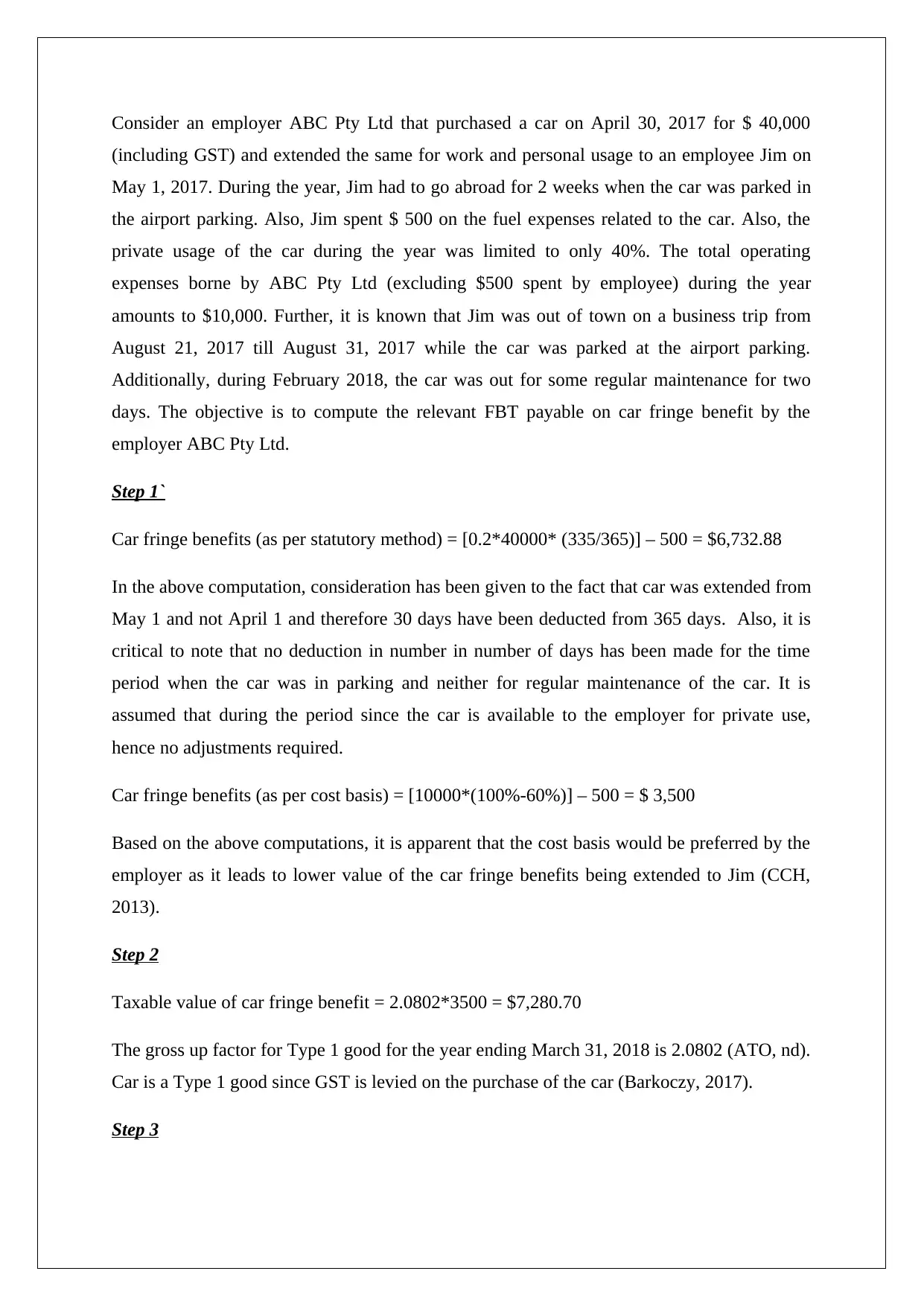
Consider an employer ABC Pty Ltd that purchased a car on April 30, 2017 for $ 40,000
(including GST) and extended the same for work and personal usage to an employee Jim on
May 1, 2017. During the year, Jim had to go abroad for 2 weeks when the car was parked in
the airport parking. Also, Jim spent $ 500 on the fuel expenses related to the car. Also, the
private usage of the car during the year was limited to only 40%. The total operating
expenses borne by ABC Pty Ltd (excluding $500 spent by employee) during the year
amounts to $10,000. Further, it is known that Jim was out of town on a business trip from
August 21, 2017 till August 31, 2017 while the car was parked at the airport parking.
Additionally, during February 2018, the car was out for some regular maintenance for two
days. The objective is to compute the relevant FBT payable on car fringe benefit by the
employer ABC Pty Ltd.
Step 1`
Car fringe benefits (as per statutory method) = [0.2*40000* (335/365)] – 500 = $6,732.88
In the above computation, consideration has been given to the fact that car was extended from
May 1 and not April 1 and therefore 30 days have been deducted from 365 days. Also, it is
critical to note that no deduction in number in number of days has been made for the time
period when the car was in parking and neither for regular maintenance of the car. It is
assumed that during the period since the car is available to the employer for private use,
hence no adjustments required.
Car fringe benefits (as per cost basis) = [10000*(100%-60%)] – 500 = $ 3,500
Based on the above computations, it is apparent that the cost basis would be preferred by the
employer as it leads to lower value of the car fringe benefits being extended to Jim (CCH,
2013).
Step 2
Taxable value of car fringe benefit = 2.0802*3500 = $7,280.70
The gross up factor for Type 1 good for the year ending March 31, 2018 is 2.0802 (ATO, nd).
Car is a Type 1 good since GST is levied on the purchase of the car (Barkoczy, 2017).
Step 3
(including GST) and extended the same for work and personal usage to an employee Jim on
May 1, 2017. During the year, Jim had to go abroad for 2 weeks when the car was parked in
the airport parking. Also, Jim spent $ 500 on the fuel expenses related to the car. Also, the
private usage of the car during the year was limited to only 40%. The total operating
expenses borne by ABC Pty Ltd (excluding $500 spent by employee) during the year
amounts to $10,000. Further, it is known that Jim was out of town on a business trip from
August 21, 2017 till August 31, 2017 while the car was parked at the airport parking.
Additionally, during February 2018, the car was out for some regular maintenance for two
days. The objective is to compute the relevant FBT payable on car fringe benefit by the
employer ABC Pty Ltd.
Step 1`
Car fringe benefits (as per statutory method) = [0.2*40000* (335/365)] – 500 = $6,732.88
In the above computation, consideration has been given to the fact that car was extended from
May 1 and not April 1 and therefore 30 days have been deducted from 365 days. Also, it is
critical to note that no deduction in number in number of days has been made for the time
period when the car was in parking and neither for regular maintenance of the car. It is
assumed that during the period since the car is available to the employer for private use,
hence no adjustments required.
Car fringe benefits (as per cost basis) = [10000*(100%-60%)] – 500 = $ 3,500
Based on the above computations, it is apparent that the cost basis would be preferred by the
employer as it leads to lower value of the car fringe benefits being extended to Jim (CCH,
2013).
Step 2
Taxable value of car fringe benefit = 2.0802*3500 = $7,280.70
The gross up factor for Type 1 good for the year ending March 31, 2018 is 2.0802 (ATO, nd).
Car is a Type 1 good since GST is levied on the purchase of the car (Barkoczy, 2017).
Step 3
⊘ This is a preview!⊘
Do you want full access?
Subscribe today to unlock all pages.

Trusted by 1+ million students worldwide
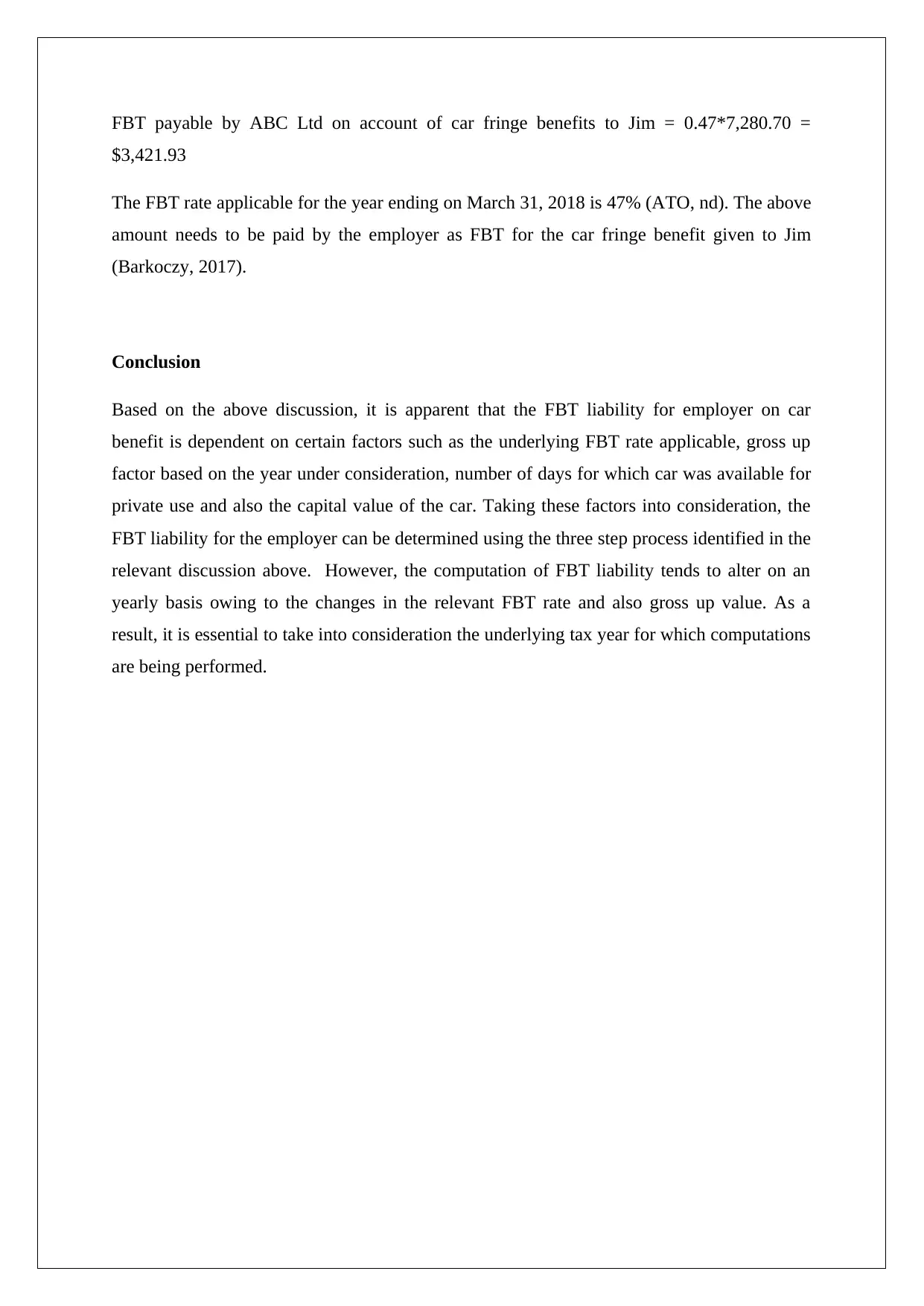
FBT payable by ABC Ltd on account of car fringe benefits to Jim = 0.47*7,280.70 =
$3,421.93
The FBT rate applicable for the year ending on March 31, 2018 is 47% (ATO, nd). The above
amount needs to be paid by the employer as FBT for the car fringe benefit given to Jim
(Barkoczy, 2017).
Conclusion
Based on the above discussion, it is apparent that the FBT liability for employer on car
benefit is dependent on certain factors such as the underlying FBT rate applicable, gross up
factor based on the year under consideration, number of days for which car was available for
private use and also the capital value of the car. Taking these factors into consideration, the
FBT liability for the employer can be determined using the three step process identified in the
relevant discussion above. However, the computation of FBT liability tends to alter on an
yearly basis owing to the changes in the relevant FBT rate and also gross up value. As a
result, it is essential to take into consideration the underlying tax year for which computations
are being performed.
$3,421.93
The FBT rate applicable for the year ending on March 31, 2018 is 47% (ATO, nd). The above
amount needs to be paid by the employer as FBT for the car fringe benefit given to Jim
(Barkoczy, 2017).
Conclusion
Based on the above discussion, it is apparent that the FBT liability for employer on car
benefit is dependent on certain factors such as the underlying FBT rate applicable, gross up
factor based on the year under consideration, number of days for which car was available for
private use and also the capital value of the car. Taking these factors into consideration, the
FBT liability for the employer can be determined using the three step process identified in the
relevant discussion above. However, the computation of FBT liability tends to alter on an
yearly basis owing to the changes in the relevant FBT rate and also gross up value. As a
result, it is essential to take into consideration the underlying tax year for which computations
are being performed.
Paraphrase This Document
Need a fresh take? Get an instant paraphrase of this document with our AI Paraphraser

References
ATO (n.d.) Fringe benefits tax – rates and thresholds, Retrieved from
https://www.ato.gov.au/Rates/FBT/
Barkoczy, S. (2017) Foundation of Taxation Law 2017. 9th ed. Sydney: Oxford University
Press.
CCH (2013), Australian Master Tax Guide 2013, 51st ed., Sydney: Wolters Kluwer.
Deutsch, R., Freizer, M., Fullerton, I., Hanley, P., & Snape, T. (2016) Australian tax
handbook. 8th ed. Pymont: Thomson Reuters.
Krever, R. (2016) Australian Taxation Law Cases 2017 2nd ed. Brisbane: THOMSON
LAWBOOK Company.
Sadiq, K, Coleman, C, Hanegbi, R, Jogarajan, S, Krever, R, Obst, W, & Ting, A
(2016) , Principles of Taxation Law 2016, 8th ed., Pymont: Thomson Reuters
Woellner, R (2014), Australian taxation law 2014 7th ed. North Ryde: CCH Australia
ATO (n.d.) Fringe benefits tax – rates and thresholds, Retrieved from
https://www.ato.gov.au/Rates/FBT/
Barkoczy, S. (2017) Foundation of Taxation Law 2017. 9th ed. Sydney: Oxford University
Press.
CCH (2013), Australian Master Tax Guide 2013, 51st ed., Sydney: Wolters Kluwer.
Deutsch, R., Freizer, M., Fullerton, I., Hanley, P., & Snape, T. (2016) Australian tax
handbook. 8th ed. Pymont: Thomson Reuters.
Krever, R. (2016) Australian Taxation Law Cases 2017 2nd ed. Brisbane: THOMSON
LAWBOOK Company.
Sadiq, K, Coleman, C, Hanegbi, R, Jogarajan, S, Krever, R, Obst, W, & Ting, A
(2016) , Principles of Taxation Law 2016, 8th ed., Pymont: Thomson Reuters
Woellner, R (2014), Australian taxation law 2014 7th ed. North Ryde: CCH Australia
1 out of 8
Related Documents
Your All-in-One AI-Powered Toolkit for Academic Success.
+13062052269
info@desklib.com
Available 24*7 on WhatsApp / Email
![[object Object]](/_next/static/media/star-bottom.7253800d.svg)
Unlock your academic potential
Copyright © 2020–2025 A2Z Services. All Rights Reserved. Developed and managed by ZUCOL.




